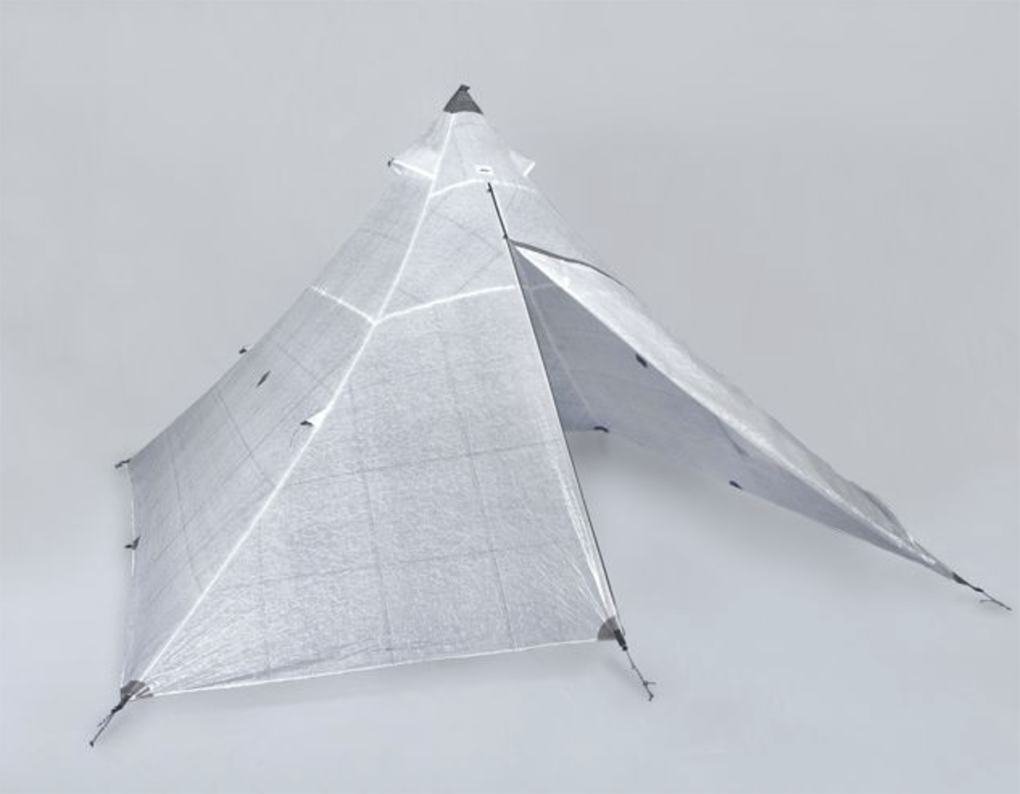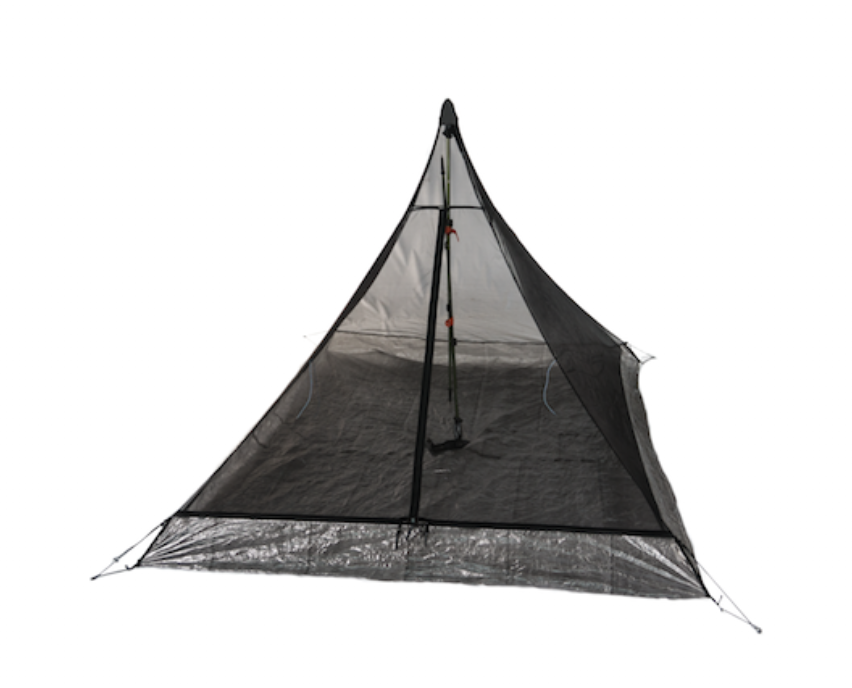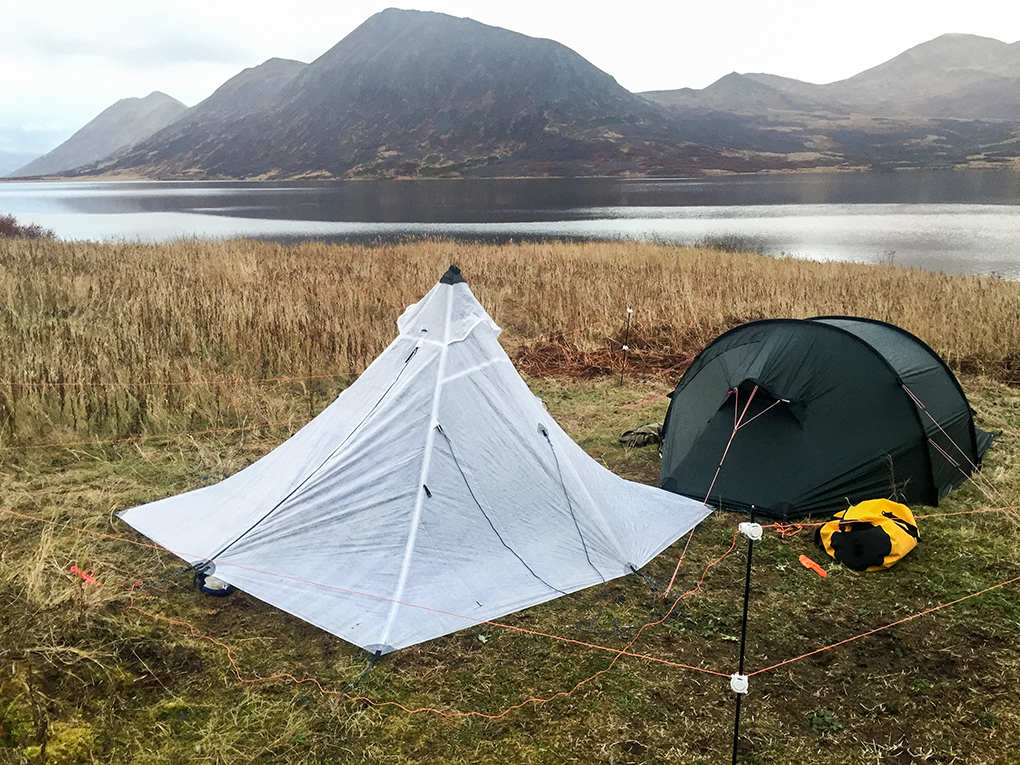
HMG UltaMid 2 and Insert
Materials: CF8 Cuben Fiber
UltaMid Features:
- Fully seam sealed
- Waterproof two-way zipper
- Comes with an X-Large CF8 Stuff Sack for storage
- 8 reinforced perimeter tie-outs
- Line locks on all perimeter tie-outs
- 4 center panel tie-outs
- Specially designed cone to prevent deformation when using oddly shaped poles, paddles, sticks or skis
- Dual peak vents that can open and close
- Vents covered with no-see-um netting
- Tie out on cone for hanging the mid from a tree
- Larger than traditional mids
- Equipped with eight 3’ Spectra Core Guy Lines for perimeter tie-outs
- Includes additional 100’ of Spectra Core Guy Lines for center panel tie-outs
- Can be pitched high off the ground or tight to the ground

Insert Features:
- Top, center-pole point reinforced with Dyneema® Hardline
- Adjustable shockcord with glovehooks attach corners to shelter
- Vertical two-way zipper running from floor to shelter door with two horizontal zippers running the width of the floor allows for easy exit and entry
- Sewn-in guyline for tying back door panels
- CF11 Cuben Fiber bathtub floor
- Center of floor reinforced with 150d Cuben Fiber for pole contact point
Blister’s Measured Weight:
- UltaMid 2: 602 g (including about 100 g of 100 ft of 2.8 mm Spectra guy-line)
- Insert with Cuben Fiber floor: 600 g
- Total: 1202 grams
MSRP: UltaMid 2: $675
MSRP: Insert: $375
Test Location: Kodiak Island, Alaska
Days tested: 15
Intro
Hyperlite Mountain Gear specializes in ultralight gear, and in particular, products made from a strong, ultralight, waterproof material called Cuben Fiber (see below).
In my circle of friends in Alaska, HMG is well known as a producer of backpacks and shelters that are optimized for all types of human-powered wilderness adventures. (For some ideas of these kinds of trips, check out the website of my close friend, Luc Mehl, at thingstolucat.com)
HMG describes the UltaMid 2 as, “small, light, and fast adventures deserve ultralight, durable shelters optimized for the task. We considered your minimalist solo and two-person alpine climbing and super-ultra thru-hiking adventures when we developed the UltaMid 2-person shelter. Made with 100% waterproof Cuben Fiber, this pyramid tent withstands the worst weather conditions, keeping you protected from raging windstorms and heavy snowfall.”

In addition I also tested the UltaMid 2 insert with Cuben Fiber floor which HMG describes as: “our four-wall UltaMid 2 Insert with no-see-um mesh for backcountry multi-sport adventurers who want to keep the bugs at bay. Built to fit into the UltaMids, this product comes with a 100% waterproof, Cuben Fiber bathtub floor that can provide you with significant protection should you be caught in a downpour. And fear not, water from condensation won’t drip, drip, drip on you in the morning; the inserts were designed a bit smaller than the perimeter of the UltaMid, so the netting never touches the walls. This UltaMid 2 Insert would be a great option for small parties of climbers, thru-hikers or backpackers heading to the wettest, buggiest places in the world.”
Over a typical year I spend a lot of nights sleeping in a tent, and most of the time I’m carrying not only my camping equipment and food, but also various other gear including packrafts, whitewater kayaks, skis, or hunting or fishing equipment.
Because I usually carry much of this other extra gear and am often out for extended periods of time, I am always looking for ways to lighten my load without significantly compromising safety and performance. The HMG UltaMid 2 caught my attention as an ultralight shelter that should be able to handle some harsh conditions all year round.
After receiving the UltaMid 2 late this past summer, I spent several trips using it primarily on Kodiak Island, Alaska. Kodiak is a place well known for extremely harsh, wet, cold, and windy weather. My trips around the island this year certainly followed that pattern, and I didn’t have any trouble finding appropriate conditions to test the UltaMid 2.
Material
I’ve done a lot of research about Cuben Fiber, and have had many conversations with friends about their personal experience using very types of outdoor equipment from it. I’ve yet to find a better description of the fabric, its content, history, and application than that available on the HMG site:
“Dyneema® (non-woven) Cuben Fiber: This high-performance, non-woven, rip-stop, composite laminate developed in the 1990s by a nuclear weapons physicist and an aerospace composite engineer. Originally designed for use in world-class sailing, it’s ideal for lightweight and ultralight outdoor gear due to its unmatched strength-to-weight ratio. Technically speaking, Cuben Fiber is a laminated fabric made using patented technologies with unidirectional prepregnated tapes of in-line plasma treated fibers that are spread into mono-filament level films. In more simple terms, Cuben Fiber is made by sandwiching Dyneema® polyethylene fiber filaments a thousandth of an inch thick, in various arrangements between thin outer layers of polyester film. The “sandwich” is then melded together in a high-pressure autoclave.
Cuben Fiber is lightweight, highly durable, and is 50-70% lighter than Kevlar, four times stronger than Kevlar, and allows flex without losing strength. It also weighs less than silnylon, it floats on water, is 100% waterproof and has high chemical and UV resistance.”
I have personal experience using Cuben Fiber packs, a bivy sack, stuff sacks, zippered load cells, and even a wallet—all in addition to the UltaMid 2—and have so far been quite impressed with the material.
The only issue I have noticed, particularly in packs, is that despite the excellent tensile strength and waterproofing, it is still sometimes susceptible to damage from abrasion such as rocks or ski edges, or even high intensity bushwhacking. That said, friends of mine have done battle with some of the fiercest “schwacks” imaginable and have come away with little-to-no pack damage.
Design
Many readers will be familiar with the concept of pyramid (or “mid”) shelters, which have been popular among wilderness travelers for decades. My introduction to them came spending quite a few nights in the original Black Diamond Mega Mid, and more recently, the SilNylon version, the Mega Light, in addition to a handful of others over the years.
Most shelters of this type employ a single pole in the middle of the shelter. Black Diamond includes an adjustable carbon pole with the Mega Light, but most people I know who use this style of shelter utilize ski / trekking poles or paddle shafts to save weight. One advantage of this type of “tent pole” is that it’s very strong and rigid compared to the long, flexible aluminum or carbon poles that we commonly associate with most types of tents. I’ll elaborate more on this below when discussing the weather resilience of the UltaMid.
NEXT: Tie-Down Points, Seam Sealing, Etc.

Hyperlight make quality gear – but too heavy. This combo is 1.2kgs! I would recommend the ZPacks Duplex at 595grams – I have both their solo and duo Cuben tents – I can’t fault their excellent design, quality and performance.
Thanks Rob, I’d love to try the Zpacks stuff. I’ve tried shelters of that shape before and, as of now, I prefer the single pole mid shape for super harsh, wet environments as it is very strong, allows me to use paddle shafts and other weird pole configurations and seems to provide a lot of space. That said, I’d love to try the Duplex.
Awesome review, Paul. The UltaMid 2 seems to be what I’m looking for, and the main shortcoming from my perspective is that that you cannot set up an insert last if you’re pitching in the rain. But even if you have that option, (like with the Stratospire) are you realistically going to keep all the rain out while you do it? I don’t have enough backcountry experience to know if my concern is warranted, do you have any thoughts on that?
In this video he sets up the tent first then does the insert. If you just get under it, instead of opening it and securing the flaps like he does, you should be able to keep the inside dry.
(moderator’s note: the video referenced has been deleted)
I am struggling with the idea of doubling the weight of the Ultamid to have it be bug proof, especially for long haul use on through hikes. Last year on the PCT I used the Black Diamond Beta Light shelter, without the insert. It is one pound. I will say that I really love that tent. My strategy for bug-proofing it, was to pitch it as low as I could to the ground and even gently lay some rocks over the edge to be sure to keep the mosquitos and flies out. This worked fairly well… about 85% mosquito proof. BUT a handful of nights were so hot and muggy from the heat and no ventilation from it being pitched without the air gap at the base, that there was a moment that I swore to myself “never again” (still it was better than being bit endlessly). I see that the Ultamid has ventilation at the top, which is very attractive to me, given my previous greenhouse experience. I would love to know if or what you and other people do to ‘bug proof” the Ultamid 2, without buying the insert? Secondly, Mountain Laurel Designs has a the Duomid XL which is Cuban fiber, comes sealed, is 7.5x9ft and has top ventilation –it seems to me to be the spitting image of the Ultamid (slight difference in that the pole is more in the front of the mid, allowing there to be more space behind the pole, rather than equal distance on each side), but the MLD design has a $50 option of having a short veil of netting along the bottom perimeter, but are otherwise just about same size/price/weight. I am having a hard time seeing why HMG Ultamid is better, equal to, or inferior to MLD Duomid. Lastly, what is the favorite ground cloth to use in bottomless shelter though hike scenario (wanting protection from the dusty or very wet ground?
Heather, I’ve heard some folks on Backpackinglight.com talk about netting (not just with the MLD) freeze to the ground overnight and be problematic dealing with that in the morning. Just something to think about.
Awesome review, thanks Paul!
It is the first in depth review I found to be realistic and done with a lot of experience.
I currently think about how to shave weight on my setup without sacrificing comfort and security in bad weather. (Mostly for treks in Iceland and Alaska.)
For me nearly as important as security is comfort in a storm because psychologically it might get difficult if you trap 2 persons in an uncomfortable shelter for 2 or 3 days waiting out a storm..
I hate drafts in the tent as I feel they lower the felt temperature quite a lot.
I was surprised to read that the mesh inner helps so much with this issue. I thought only a solid inner would significantly reduce the draft…
The other concern I recently have is the actual set up of the shelter when the storm is already blowing. I own a Stratospire and a MSR Guideline Pro. Especially the Guideline Pro is incredibly strong in the wind because of the unique pole design. Permanantly fixed at the crosspoints, it’s the only geodestic design I know using this technique and it works really good.
But I have a big concern about both tents to be set up when the storm already kicked in. The Guideline Pro is inner first and I think if you have a severe storm going you will not be able to get it up anymore. Same with the Stratospire 2.
So I was looking at the Nammatj 3 because the Hilleberg videos of how to set it up during a storm are impressive. So easy, even alone.. But not lighter than my actual setup.
I appreciate your detailed description on how to set up the Ultamid in a storm.
Will this work with the inner as well?? I can’t imagine seting up the inner first and after that pulling the outer over with high winds involved.
Can you share insights with us about that specific case as well?
Best regards,
Philip